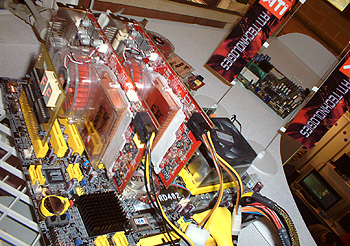Introduction
A recent release of some ATI Crossfire benchmarks on a site in Hong Kong has caused me to have another look at some sneaky benchmarks we ran back at Computex with DFI. On DFI's stand upstairs they had an in-dvelopment ATI Crossfire setup running using their own ATI Xpress 200 Crossfire Edition-based LanPartyUT RDX200 mainboard. A pair of Radeon X850 XT boards on PCI Express were pushing the pixels, one the Crossfire master board that holds the brand new Xylinx FPGA programmable chip, the main task of which is to combine the frames from the two boards before output. The other board was your common or garden variety X850 XT that a few of you might own already.Want a peek? Blame PD for the blurry spyshot-esque camera work. Click on the final three for larger versions.

Note the multi-VPU designation in the driver control panel. That's what shows up when you're running Crossfire in slave-slave mode. Slave-slave mode limits you to alternate frame rendering mode within Crossfire, as a means to speed up rendering, or SuperAA mode as a means to increase image quality. Supertiling and scissor are unavailable if you don't have the Xylinx FPGA to put the image back together.
In slave-slave AFR mode, you don't get the display output at any time from the second board, since there's no compositing chip to display it and the finished frame isn't sent over the PCI Express bus either. So while each board is rendering separate frames, half the frames are never displayed since the second board doesn't push them to the first. So you get inflated benchmark results without seeing all the frames on your screen.
The driver uses the marketing name Crossfire when you're running with a master board with the FPGA. So without giving much more of the game away, fancy a peek at the early performance the hardware had at Computex, using 3DMark05?












